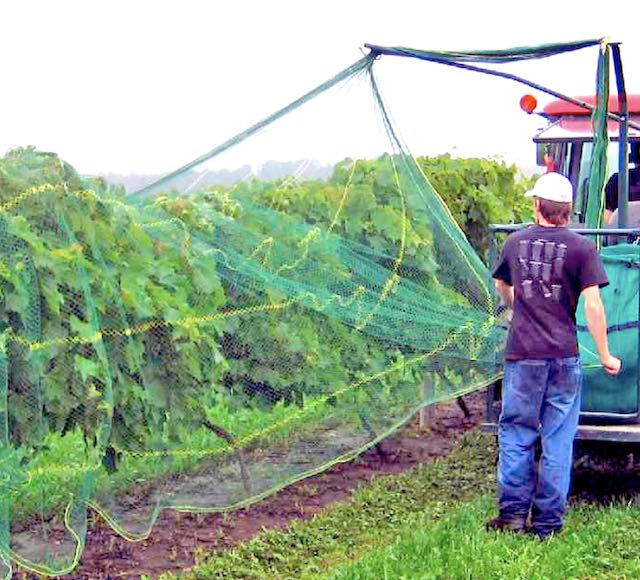Wildlife Control in the Vineyard (Grapevine Magazine)

Many vineyards focus their pest control efforts on small common insects, but there are much larger animals that put grapevines in danger as well. Rodents, birds, deer and other larger mammals feed and trample on grapevines, putting production at risk and compromising the quality of wine grapes.
Types of Wildlife in Vineyards
Depending on what region of the country your vineyard is located, you may be faced with many different animals that love to wander into your grapevines. Some of the most common wildlife species that negatively impact vineyards are deer, rodents, birds and raccoons. Birds, in particular, are notorious for pecking through fruit and damaging it so that it cannot be used for winemaking.
“Many different avian species can damage vineyards, but the most aggressive ones are flocking birds like starlings and blackbirds,” said Cory Gellerstedt, Co-president of Nixalite of America. “Even one bird peck to a grape can leave detrimental pathogens that can alter the taste of the fruit.” Based in East Moline, Illinois, Nixalite specializes in pest bird and wildlife control products, including bird netting, bird spikes and deer fencing.
“In larger vineyards, the loss of crops due to bird damage could be as high as 10-30%, resulting in millions of dollars’ worth of lost revenue, and in smaller vineyards, that percentage could be much higher, sometimes resulting in a total loss,” said Vahe’Alaverdian, master falconer and founder of Falcon Force.
Even if wildlife pests don’t eat the fruit on your vines, they may tear through leaves or damage shoots so that they no longer support the plant.
However, not all types of animals are a nuisance. Both sheep and geese provide weed control, llamas can be used to clear debris from vineyard rows, and armadillos are known to eat harmful insects. Meanwhile, dogs, outdoor cats and even bobcats scare away rodents and other small pests and protect sheep from predators.
Chemical Control Methods
Brett Miller, Northwest Territory Sales Manager for the Wilsonville, Oregon-based Bird Control Group, told The Grapevine Magazine that chemical repellents come in two modalities: primary and secondary. Primary repellents are irritants that produce a foul odor or taste to encourage birds to try a different food source, while secondary repellents invoke a physiological response in the birds.
Chemicals repellants are sprayed either directly onto fruit or into the air around the vineyard; however, as a former vineyard manager and winemaker, Miller said to be careful when spraying any chemical directly onto the grapes. “Spraying anything on the fruit or in the vineyard will affect the resulting wine in some way. I would never spray something on the fruit that is a physical deterrent to birds because it could easily affect the quality of the wine, whether directly by an off-taste, or indirectly by inhibiting yeast fermentation.”
Jon Stone of Avian Enterprises in Sylvan Lake, Michigan, told The Grapevine Magazine that Avian Control Bird Repellent has proven to be the most effective chemical control method on the market for controlling birds in vineyards. The main reason for this, Stone said, besides it’s effectiveness, is that it does not change the taste or color of the wine.
“There have been no reports of unexpected changes in any wine made with grapes that have been treated with Avian Control,” said Stone. “The active and inert ingredients in Avian Control do not penetrate the skin of the fruit. Avian Control will not translocate into the treated crop. Translocation is the tendency of a compound to move through the tissues of a plant. This effect is particularly troubling when repellents translocate from the outer skin of the fruit through the skin and into the fruit body. When this occurs, a distinct change in taste can be noticed. Due to its unique formulation, Avian Control remains on the surface… and does not translocate into the plant or its fruit, preserving the natural taste of the crop. This is an important difference between Avian Control and other bird repellent products currently available.”
Stone said that Avian Control repels only birds and has no effect on humans or domestic animals. The active ingredient, methyl anthranilate, is widely used in foods designed for human consumption. The FDA has classified all of the ingredients in the Avian Control formula to be “Generally Regarded as Safe”.
The same cannot be said for rodent control. Allen Hurlburt of H&M Gopher Control in Tulelake, California, said that all chemical rodent controls, such as strychnine baits, aluminum phosphide (phostoxin), and anti-coagulants, are problematic because their effects are not limited to the targeted rodent.
“Phostoxin, especially, is very dangerous for the operator to handle,” Hurlburt said. “Regulations vary from state to state, but materials can be difficult to obtain and usually require permits from county agricultural departments.”

